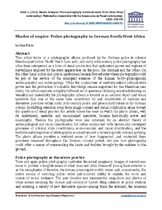| dc.contributor.author | Rizzo, Lorena | |
| dc.date.accessioned | 2017-09-29T06:33:22Z | |
| dc.date.available | 2017-09-29T06:33:22Z | |
| dc.date.issued | 2013 | |
| dc.identifier.citation | Rizzo, L. (2013). Shades of empire: police photography in German South-West Africa. Visual Anthropology, 26(4): 328-354 | en_US |
| dc.identifier.issn | 0894-9468 | |
| dc.identifier.uri | http://dx.doi.org/10.1080/08949468.2013.804701 | |
| dc.identifier.uri | http://hdl.handle.net/10566/3217 | |
| dc.description.abstract | This article looks at a photographic album produced by the German police in colonial Namibia just before World War I. Late 19th- and early 20th-century police photography has often been interpreted as a form of visual production that epitomized power and regimes of surveillance imposed by the state apparatuses on the poor, the criminal and the Other. On the other hand police and prison institutions became favored sites where photography could be put at the service of the emergent sciences of the human body—physiognomy, anthropometry and anthropology. While the conjuncture of institutionalized colonial state power and the production of scientific knowledge remain important for this Namibian case study, the article explores a slightly different set of questions. Echoing recent scholarship on visuality and materiality the photographic album is treated as an archival object and visual narrative that was at the same time constituted by and constitutive of material and discursive practices within early 20th-century police and prison institutions in the German colony. By shifting attention away from image content and visual codification alone toward the question of visual practice the article traces the ways in which the photo album, with its ambivalent, unstable and uncontained narrative, became historically active and meaningful. Therein the photographs were less informed by an abstract theory of anthropological and racial classification but rather entrenched with historically contingent processes of colonial state constitution, socioeconomic and racial stratification, and the institutional integration of photography as a medium and a technology into colonial policing. The photo album provides a textured sense of how fragmented and contested these processes remained throughout the German colonial period, but also how photography could offer a means of transcending the limits and frailties brought by the realities on the ground. | en_US |
| dc.language.iso | en | en_US |
| dc.publisher | Taylor & Francis | en_US |
| dc.rights | This is the author-version of the article published online at: http://dx.doi.org/10.1080/08949468.2013.804701 | |
| dc.subject | Namibia | en_US |
| dc.subject | Photography | en_US |
| dc.subject | Police | en_US |
| dc.subject | German colony | en_US |
| dc.title | Shades of empire: police photography in German South-West Africa | en_US |
| dc.type | Article | en_US |
| dc.privacy.showsubmitter | FALSE | |
| dc.status.ispeerreviewed | TRUE | |
| dc.description.accreditation | International Bibliography of Social Sciences | |

